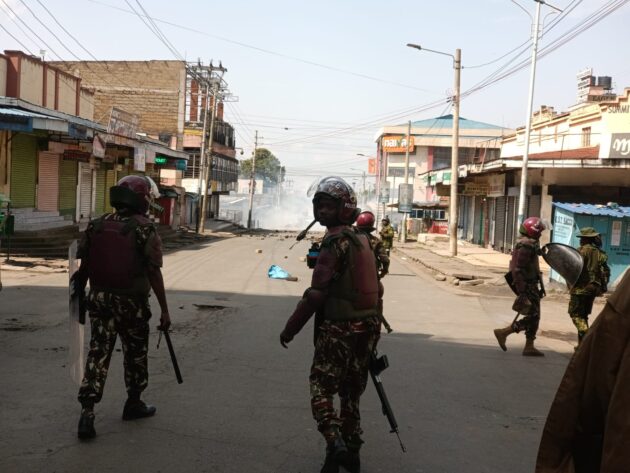
Protests Erupt in Ndumberi After 7-Year-Old Girl Killed by Police Bullet Inside Her Home » Capital News
KIAMBU, Kenya July 8– Fresh anti-police protests have broken out in Ndumberi, Kiambu County, following the tragic killing of 7-year-old girl, who was struck by a stray bullet fired by police during the Saba Saba protests on Monday.
Bridget Njoki Wainaina was inside their home with her parents when a bullet—allegedly fired by officers during a confrontation with protesters outside—pierced through the house wall and fatally wounded her.
The incident has triggered widespread outrage, grief, and street protests, with angry residents engaging police in running battles on Tuesday, accusing the security forces of recklessly endangering innocent lives in residential areas.
Wainaina, a student who had stayed home from school that day due to heightened tensions in the area, was seated in their living room when the bullet struck.
Speaking to journalists, her distraught mother recounted the horrifying moment that changed their lives forever.
“It was around 6:20pm when we heard a loud bang. On checking on my daughter, I saw blood on her hands. At first, I thought she had scratched herself. But when I looked closely, there was a hole in her head. I screamed for help, and her father came running,” she said.
The family rushed her to St. Bridget’s Hospital, where doctors attempted to resuscitate her and prepare for emergency surgery. Sadly, her heart had already stopped. After multiple attempts, doctors were forced to declare her dead.
The young girl’s mother described her as a bright, respectful, and hardworking child with big dreams, now tragically cut short by what she called “a careless and unjust act of violence.”
Public Outrage and Condemnation
The killing of Bridget Wainaina has sparked national mourning and ignited sharp criticism of the police and government, particularly in the wake of recent shoot-to-kill remarks by Interior Cabinet Secretary Kipchumba Murkomen.
Local leaders, including Githunguri MP Gathoni Wamuchomba, condemned the killing and laid the blame squarely on recent directives encouraging the use of live fire during protests.
“I’m in pain and defeated to see many young people die from bullets during demonstrations,” Wamuchomba said. “We can confirm that the recent order to shoot to kill by the Security Minister was taken seriously. But why shoot to kill an innocent girl?”
Wamuchomba and other leaders have demanded immediate accountability, while human rights groups are calling for an independent investigation into the shooting and all protest-related deaths.
A Disturbing Pattern
Bridget’s death follows a similar incident last year. On July 1, 2024, during Gen Z-led protests, 12-year-old Kennedy Onyango was killed in Nairobi while walking to a neighbour’s house to pick up a schoolbook. He was shot eight times, according to witness reports, during a night marred by violence and looting.
Bridget becomes yet another young casualty in what critics say is a growing pattern of police brutality and impunity during protests.
Her killing also brings into sharp focus the dangerous militarisation of protest response in Kenya, where children and bystanders are increasingly paying the price for unrestrained state action.
Calls for Accountability
Human rights organisations, including the Kenya National Commission on Human Rights (KNCHR) and the UN Human Rights Office, have called for independent and transparent investigations into police killings during protests, and for those responsible to be held to account.
“No child should die in their own home at the hands of the police,” one rights activist said during a vigil in Kiambu. “This is not just a tragedy—it’s a national shame.”
As protests intensify in Ndumberi and other parts of the country, pressure is mounting on the government to take responsibility, prosecute officers involved in unjustified killings, and uphold the constitutional right to life and peaceful assembly.
Bridget Wainaina’s death has now become a painful symbol of the growing crisis between state authority and public outrage—and a chilling reminder of the human cost of unchecked power.